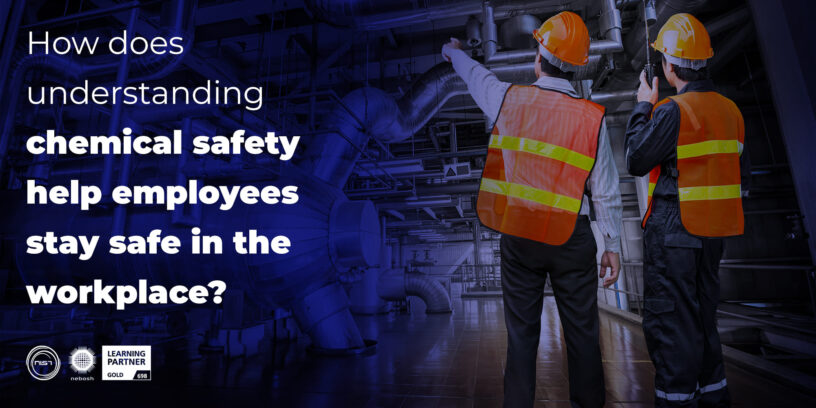Chemicals are essential in every aspect of human life, including what we eat, how we travel, the technology we use, and how we treat disease and illness. Human lives are intrinsically tied to chemicals that directly improve our well-being. Hence, the chemical industries are required to balance the bridge between demand and sophisticated living. Also, industrialization increased the exposure to chemicals at home & the workplace.
Across the globe, now at an alarming rate, exposure to chemicals has increased the prevalence & incidence of chronic health conditions such as cancer, cardiovascular diseases, neurodevelopmental & congenital defects.
The data from the World Health Organisation (WHO) shows that occupational exposure to chemicals globally accounts for 1303 100 million deaths (2.3% of the total) and 43 109 000 DALYS – Disability Adjusted Life Years (1.6 % of the total). This proves that manufacturing & production of the chemicals is negatively affecting the workers’ health and safety.
Chemical Exposure
Although chemical products benefit human lives in many ways, they also have detrimental effects. The exposure of chemicals to the human body occurs in many ways, such as inhalation, absorption, ingestion, and injection, which affects the respiratory, digestive, circulating, and nervous systems and leads to acute (short term health effects) & chronic (long-term health effects) diseases. The chemicals are basically classified into asphyxiants, corrosives, irritants, sensitizers, carcinogens, mutagens, and teratogens, based on their hazardous properties.
At the workplace, the employer can carry out a suitable & sufficient risk assessment to identify the risk related to specific chemicals, their potential consequences, and the adequacy of control measures required at the workplace. A risk assessment helps the employer understand the potential consequences of chemicals.
Why is chemical safety important?
Chemical exposure in the workplace is unavoidable; but policies, procedures, & practices can be designed to enhance chemical safety in the workplace and minimize the risk of potentially hazardous chemicals. Indirectly, this enables the organisation to comply with the relevant National & International regulations and standard requirements.
Safety Regulations
National & International regulations exhibit the duties of employers & employees in managing chemicals in the workplace. The following are a few examples:
- According to the ILO’s Chemical Convention No. 170 and recommendation No. 177, workers have a need for and a right to know information about the chemicals they use at work. In the workplace, there should be an established principle to ensure that the chemicals are used safely.
- Registration, Evaluation, Authorization, & Restriction of Chemicals (REACH) states that the risk presented by a chemical substance in the workplace should be identified and managed effectively.
- The Control of Substances Hazardous to Health (COSHH) Regulations 2002 require an employer to protect employees from a hazardous substance by risk assessment, control of exposure, health surveillance, and incident planning.
- The Dangerous Substances and Explosive Atmosphere (DSEAR) Regulations 2002 state that employers should find out about the dangerous substances in the workplace, fire and explosion risks, and put necessary control measures in place to reduce the risk to an acceptable level.
- According to the Storage and Import of Hazardous Chemicals Rule (1989), employers are required to provide workers with information, training, and equipment to manage chemical activity safely.
- The Factories Act of 1948 states that the exposure of chemicals and toxic substances used in the manufacturing process should be within the permissible limits.
Managing chemical hazards
Chemical-related death, injury, & illness are extremely preventable by applying the hierarchy of control. The controls could be elimination, substitution, engineering, administrative control, and Personal Protective Equipment (PPE). For example, if a chemical possesses carcinogenic or poisonous properties, a less hazardous chemical can be substituted to reduce the intensity of the risk level. Also, information related to the hazardous property of the chemical can be obtained through Material Safety Data Sheets (MSDS).
What is a Material Safety Data Sheet (MSDS)?
Material Safety Data Sheets (MSDS) or Product Safety Data Sheets (PSDS) help to retrieve information related to chemicals, chemical compounds, & chemical mixtures. It has 16 pieces of information such as Chemical Product & Company Identification, Composition & Information on Ingredients, Hazard Identification, First Aid Measures, Fire Fighting Measures, Accidental Release Measures, Handling & Storage, Exposure Control & Personal Protection, Physical & Chemical Properties, Stability & Reactivity, Toxicological Information, Ecological Information, Disposal Consideration, Transport Information, Regulatory Information & other information. This comprehensive information helps to understand & proactively control the hazardous effects of chemicals. Furthermore, information related to the chemicals can be obtained through labels, placards, etc.
Chemical Emergency Preparedness
Accidental release of the chemical can occur at any time in the workplace. It will result in a fire, explosion, release of toxic gases, or spillage of a hazardous substance in storage, processing, and transportation.
The common causes of these chemical accidents could be equipment failure, design deficiency, or abnormalities in operation or maintenance. Furthermore, it can also be unsafe acts caused by human errors. To prevent the potential consequences, on-site & off-site emergency plans should be designed that will enhance the safety of the workers and plant. While planning emergency procedures, fire detection equipment, fire protection equipment, firefighting media, siting of extinguishers, first aid requirements, training requirements, and housekeeping should be considered & implemented correspondingly.
This sounds pretty basic, but it is important to understand that you aren’t always aware of what could happen in your workplace.
Importance and Benefits of Chemical Safety Training:
Chemical Safety Training: This is a must-do for all employees because it protects them from the harmful effects of chemicals on their bodies and helps them understand their work process in depth.
It’s indeed mandatory for every employee to go through chemical safety training before entering any chemical industry, as, it not only keeps you safe but also helps in safeguarding your health, making you confident while handling chemicals, increasing the organization’s productivity, and so on.
The chemical safety awareness course covers the following topics:
- How to identify common hazardous chemicals
- Understanding the basic characteristics of hazardous chemicals
- Understanding the effects of exposure to hazardous chemicals
- The importance of knowing the location and usage of hazardous chemicals in the workplace
- Prevention techniques for working safely with hazardous chemicals
- Hazardous chemical storage and handling procedures
- Identifying emergency procedures for hazardous chemical emergencies
- Proper disposal of hazardous chemicals, etc.
Why NIST:
Chemical Safety Awareness training courses help to minimize risks to workers in your facility. Our Chemical Safety Training is conducted by experienced trainers who have rich experience in this field and help students understand the working process with live examples as well as videos to support them during training sessions so that they can learn the same easily and quickly. With our Chemical Safety Awareness Program, you will be able to develop a team of safety conscious employees which will ultimately help in making sure that there is no accident or incident involving chemicals in your company’s processes and procedures within your facility which can cause huge losses to your business and may even result in death or injury to you and others if not taken care of immediately and properly! This is very important for anyone who works in an environment where chemicals are used daily such as the food industry, pharmaceutical industry, oil refinery industry, etc.. Our Chemical Hazards Awareness training courses are available for organizations to learn about the potential health hazards that may be present in their work environments.














Leave a Reply